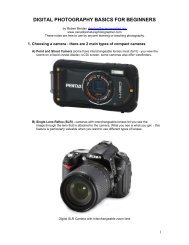Download PDF - The Canadian Nature Photographer
Download PDF - The Canadian Nature Photographer
Download PDF - The Canadian Nature Photographer
Create successful ePaper yourself
Turn your PDF publications into a flip-book with our unique Google optimized e-Paper software.
MACROPHOTOGRAPHY TOOLS, TIPS & TECHNIQUES FOR DIGITAL PHOTOGRAPHERS 2012<br />
Summary of macrophotography techniques<br />
� Most compact digital cameras with a macro mode can be used for closeup photography.<br />
� A DSLR camera offers the most flexibility and control in macrophotography.<br />
� Closeup filters (+1 to +4 diopters) screw onto the front of the lens to achieve magnification.<br />
� Closeup filters are available as single element or dual glass elements.<br />
� Extension tubes permit any lens to focus more closely and do not degrade the image quality.<br />
� Macro lenses come in three basic focal lengths: 50-60, 100-110 and 200 mm. <strong>The</strong> longer the<br />
focal length the greater the working distance between the camera lens and subject.<br />
� Bellows permit magnifications up to about 10X and are best suited for studio work.<br />
� Teleconverters (1.4, 1.5, 1.7, 2.0 and 3X) can be used with some lenses to magnify the image<br />
size, but they reduce the light coming into the camera and degrade the image quality.<br />
� A reverse lens adapter permits you to attach a lens to the camera backwards to achieve high<br />
magnification, but the lens loses its automated aperture controls.<br />
� Reversing and stacking lenses can be used to achieve high magnification.<br />
� When shooting with your camera, be sure to set the appropriate white balance or use auto<br />
white balance (AWB) if shooting RAW files.<br />
� Natural light varies in color, direction, and quality; often the best results are achieved with soft,<br />
even lighting that is available in the shade.<br />
� Side lighting and backlighting can enhance texture and provide a sense of depth to an image.<br />
� One advantage of using a flash is that the brief pulse of light permits photographers to hand<br />
hold their cameras when pursing subjects such as butterflies that move about quickly.<br />
� When using flash, be sure to check the camera exposure histogram and modify exposure<br />
compensation as required.<br />
� Flash diffusers can be used to soften the light from compact flash units.<br />
� If a background is too busy, it can be simplified by holding a piece of coloured paper or cloth<br />
behind it.<br />
� Depth of field decreases as you get closer to a subject, and the depth of field in an image is<br />
dependent on the f-stop used, with larger f-stops (smaller apertures) providing the greatest<br />
depth of field.<br />
� To achieve greater depth of field, it is possible to take several photographs with different focal<br />
points then stack and blend the photographs using software such as Adobe Photoshop.<br />
Robert Berdan | 49




